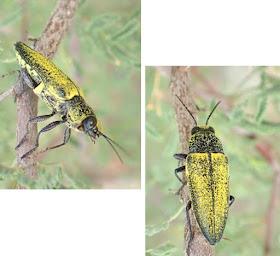During our Sky Island Safari, Joyce, Alice, Aaron and I spent 2 days and nights at Sunny Flats CG in Cave Creek Canyon. When we arrived, there was still no water in the creek, very unusual for the end of August. But clouds soon rolled in, the nights got chilly and rain was pounding the tents. In my car it was quite cozy though.
I was happy with the performance of my new little Olympus Tough4 under very dim light conditions. The colors are actually especially saturated when the light is so diffuse.
At home, at my larger PC screen I found the draw-back: the camera compensates for low light mainly by increasing the ISO numbers, which leads to granulated low resolution images.
The little flash is not very potent, but will improve the situation if I remember to control the ISO to no more than 200.
We found some nice bugs along South Fork Creek and with the help of a local birder even saw 2 juvenile Trogons.
We visited Southfork Creek in the afternoon and again in the morning, hoping for Rock Rattlers that Alice had seen here previously.
But we could find neither the snakes, nor their usually very common prey, the Mountain Spiny Lizards. We speculated about the recent fires, floods and land slides but I heard later from other herpers that Sceloporus jervey is rare this year on all sky islands.
 |
| Leptinotarsa decemlineata (Colorado Potato Beetle) on Silver-leaf Nightshade and Tetraopes discoideus on milkweed |
 |
| Wet prospective Monarchs |
 |
| Eggs of a Green Lacewing |
 |
| The Chrysis cuckoo wasp was not giving up its sleeping position while it was cold and wet |
 |
| Female Dynastes grantii (Herculaes Beetle) |
Our black lights at night brought little and mine was constantly robbed by a skunk, but Joyce got a big female Dynastes grantii. I've put that beetle up in a terrarium to hopefully lay some eggs. So far she is eating lots of apples.
While Joyce and Aaron were looking for oak galls in the canyon they were pounded by thunder storm after thunder storm.
Alice and I tried to stay in ahead of the front following Foothills Road. We were treated to dramatic sights of mountains and canyon being swallowed up by heavy clouds.
 |
| Saxinis sonorensis and trichoderes peninsularis |
 |
| Buprestids Acmaeodera disjuncta. and flavopicta |
 |
| Gyascutus caelatus still flirting despite the upcoming storm |
 |
| Cerambycids Crossidius suturalis, Plionoma suturalis and Stenaspis solitaria |
 |
| red form of Stenaspis solitaria |
Alice found a big male with lots of red on head and pronotum. First I thought it was S. verticalis, but the antennae were not annulated. A teneral S. solitaria? I kept it and it never changed color. Now I've learned that this reddish form is not totally uncommon further east in New Mexico and Texas. Foothills Rd in Portal is always good for eastern species and forms.
 |
| Acrolophitus maculipennis (Texas Point-head Grasshopper) |
A quiet evening followed the storm, but the washes were now running and more rain came at night.
In the morning the clouds were still hanging low, so we skipped our planned tour up to Rustler Park and headed for Wilcox Playa instead.












